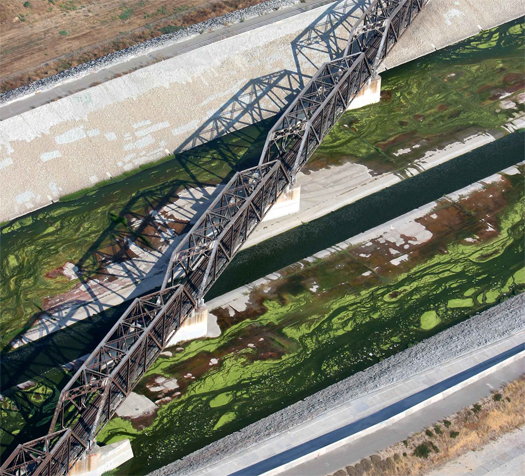
[Aerial photograph of sludge mats swirling in the Los Angeles River by flickr user Vision Aerie]
As we’re about to jump scales in our reading of The Infrastructural City — from the post-natural ecologies and mining operations of the first section of the book, “Landscape”, to the networks of cell towers and cable lines featured in the middle section, “Fabric” — I thought it would be worth excerpting a choice quotation from photographer Lane Barden’s essay “The River”, which closes that first section. In this excerpt, Barden discusses how the reality of the hydrological condition of the Los Angeles River — its “dry season base flow… consists almost entirely of treated sewage water” — differs from the image of the river constructed by the movement to restore the river (“the public is not yet fully aware that the movement to restore the Los Angeles River is a movement to restore a river that will consist primarily of recycled sewage”):
“Today, the San Fernando aquifer and adjoining aquifers in the Southern California region are depleted sub-surface reservoirs controlled and administered by the city. Because excessive storm water run-off from Los Angeles hardscape is swiftly funneled into the river, even heavy rains do little to recharge the aquifers, so ground water reserves are below capacity. This groundwater is monetized and can only be pumped out with a license and a fee. Pumping ground water into the river for restoration purposes is not an option and will not become an option. The authentic conditions of an endless supply of groundwater feeding the Los Angeles River are lost and will not be reclaimed.
Prior to 1913, the Los Angeles River and its massive ground water supply was the sole source of water for the city. After tapping the Owens Valley and the Colorado River with aqueducts hundreds of miles in length, Los Angeles was freed from its dependence on local aquifers. Water from the aqueducts that once flowed in the Colorado and Owens Rivers now flows into our sinks and toilets, then into the sewers, and onto three treatment plants located next to the L.A. River. There it gets scrubbed three times and is discharged into the river channel only to be polluted again with street runoff that includes various chemicals, oil products, hundreds of thousands of plastic bags, and coliform bacteria coming from kennels, stables, and the street.
That’s the contemporary Los Angeles River, a river that has been siphoned from outlying areas, has flowed through kitchens and bathrooms, treated before it goes into the riverbed as tertiary water, then polluted before going to the ocean. Robust community movements are now underway to clean up runoff and storm water before it enters the river to protect the tertiary base flow. Remarkably, this tertiary water, if it could remain unpolluted, is probably cleaner than the water in every urban river in the world.
Ideally, many years from now, the rain that falls in Los Angeles would be cleaned and diverted into the city’s aquifers for storage. Then, tertiary water could become the primary source for the river year round. With this in mind, a third, more adaptable image becomes possible, enabled by a constant, steady supply of clean tertiary water that could feed a linear public garden fifty miles long. It would provide as yet unimagined cultural interpretations, natural habitat, recreation, and green infrastructure for a city that has become so dispersed, park-starved, and focused on short-term problem solving that its inhabitants are hard-pressed to imagine anything beyond what the river once was and what it has become.”


[…] This post was mentioned on Twitter by jfleck, Tom Mercer. Tom Mercer said: So? The OC's drinkin' it! RT @jfleck A restored LA River would "consist primarily of recycled sewage" http://bit.ly/aarWDb […]
Llegué a tu blog y vi que todo lo que escribes es bastante interesante. Me la pasé leyendo un rato largo. Agregaré la dirección a mi lector de noticias. Si tienes ganas, pasa por mi blog. Suerte!
Encontré tu blog por pura casualidad y los artículos que publicaste me gustaron mucho. Me la pasé leyendo un rato largo. Agregaré la dirección a mi lector de noticias. Si tienes minutos libres, accede a mi sitio. Saludos!
[…] alien” as Esparza’s Nomadic Plants in L.A. They can even be helpful to reduce The Los Angeles River‘s pollution. Esparza pointed that the microorganisms that live inside the robots are […]